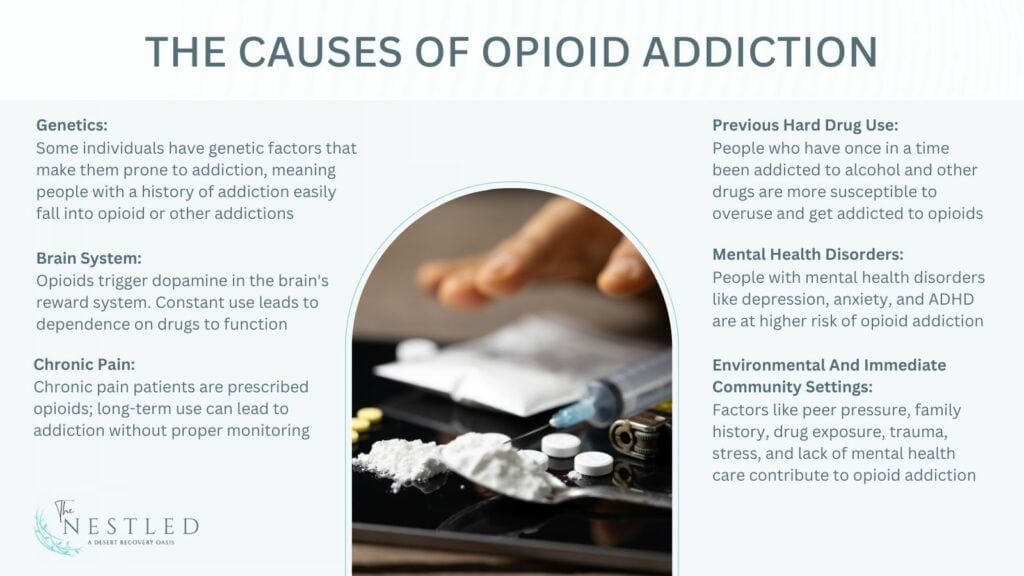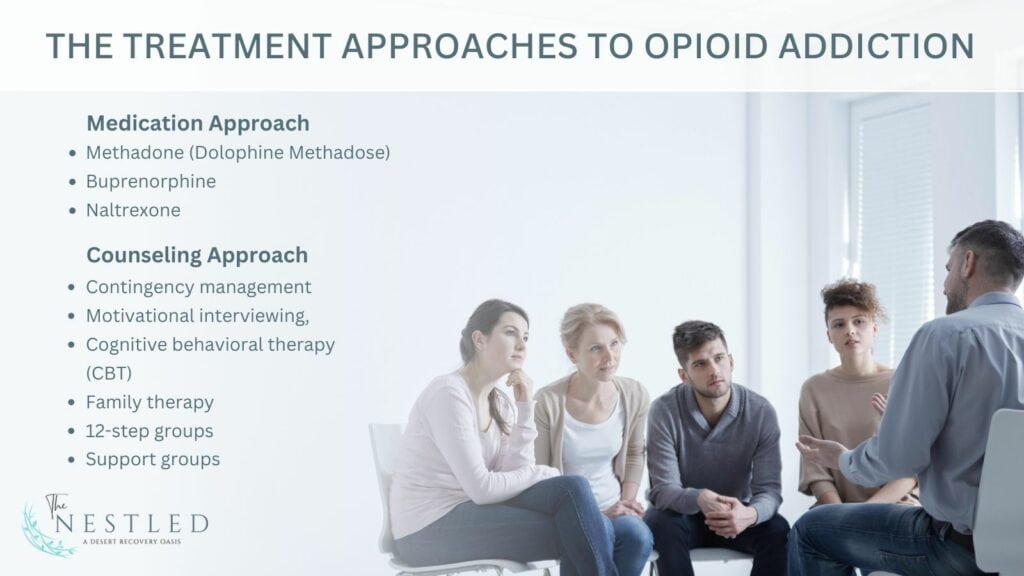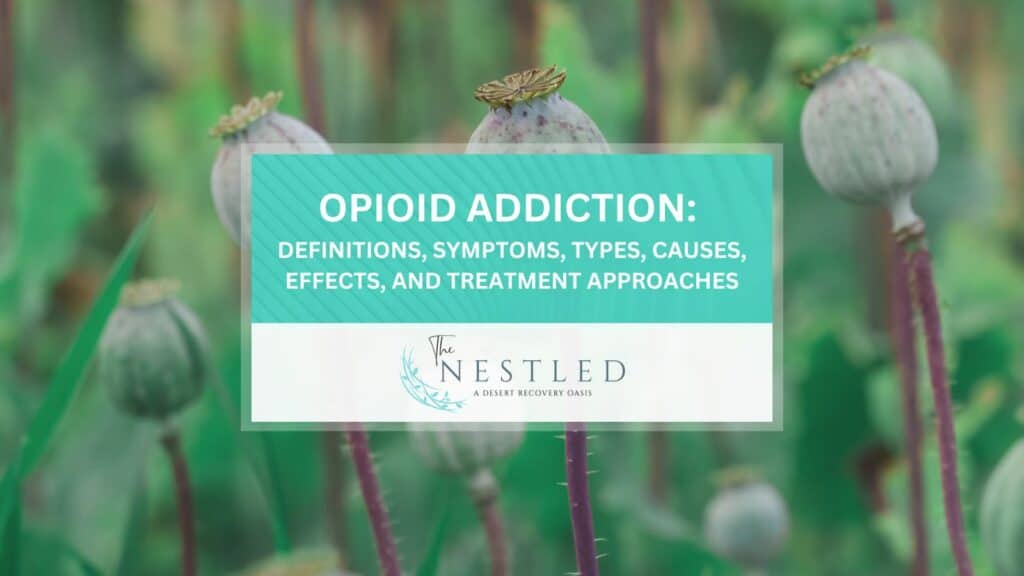Opioid addiction is a medical condition characterized by an intense and compulsive urge to use opioids despite the negative consequences it has on its users. Opioids are used medically for the management of pain, but they also have a euphoric effect, which induces people to crave them. According to the Centers for Disease Control and Prevention, the number of drug overdose deaths increased by more than 16% from 2020 to 2021. Over 75% of the nearly 107,000 drug overdose deaths in 2021 involved an opioid.
The common symptoms of opioid addiction include drug dependence behavior, various opioid prescriptions from several professionals, symptoms of opioid withdrawal when trying to quit, and excessive opioid cravings.
Types of opioid addiction include heroin addiction, fentanyl addiction, methadone addiction, polysubstance addiction, and buprenorphine addiction.
Opioid addiction is caused by both psychological and physical factors, which include compulsive use, availability of opioids, physical tolerance, the need to use excess quantity and withdrawal symptoms.
The effects of opioid addiction range from dizziness, constipation, nausea, vomiting, and even respiratory depression.
There are two main opioid treatment approaches: opioid agonist therapies using methadone and buprenorphine and addiction treatment counseling. Addiction treatment counseling involves withdrawal management and day treatment.
What Is Opioid Addiction?
Opioid addiction is a condition where a person has an intense urge to consume opioids to the extent of becoming dependent on them despite their negative consequences. Addiction to opioids happens when the brain gets used to the opioids and craves more of them to feel normal. According to the World Health Organization, about 296 million people worldwide (or 5.8% of the global population aged 15–64 years) used drugs at least once in 2021. Among them, about 60 million people used opioids. About 39.5 million people lived with drug use disorders in 2021.
Opioid addiction alters the brain’s functioning, making it hard for individuals to resist the urge to use opioids despite adverse consequences. It leads to harmful behaviors, health problems, and difficulty stopping or controlling opioid use.
The cycle of addiction is almost impossible and challenging to break without proper support and treatment, often resulting in significant disruption to one’s life and well-being.
What Are The Symptoms Of Opioid Addiction?
The symptoms of Opioid use disorder are:
- Using opioids for a long time. (12 months and above).
- Unsuccessful attempt to quit.
- Withdrawal symptoms.
- Spending a substantial amount of time to get, use, and recover from opioid use.
- Lack of accountability at home, school, or work due to the excessive use of opioids.
- Continuous use of opioids even after being diagnosed with complicated health conditions.
- Avoiding social activities and gatherings that used to be interesting to you.
- Craving to use more opioids to get the same sensation, such as relive and tolerance.
- Crushing, snorting, chewing, or injecting opioids.
- Using a particular amount of opioids earlier than prescribed.
What Are The Types Of Opioid Addiction?
The 3 types of opioid addiction are prescription opioid addiction, heroin addiction and synthetic opioid addiction.
1. Prescription Opioid Addiction
This type of addiction begins with the prescribed use of opioids for pain management. Users may develop a dependency after prolonged use or begin misusing the medication by taking higher doses than prescribed, taking it more frequently, or using it in a way not intended by the prescription (such as crushing pills to snort or inject them).
Common prescription opioids include:
- Oxycodone (OxyContin, Percocet)
- Hydrocodone (Vicodin)
- Morphine
- Fentanyl
- Methadone
2. Heroin Addiction
Heroin is an illegal opioid known for its high potential for addiction. Many individuals turn to heroin after developing a dependency on prescription opioids because it can be cheaper and more accessible. Heroin is often more dangerous due to the lack of control over the drug’s purity and the potential for it to be mixed with other harmful substances.
3. Synthetic Opioid Addiction
This involves addiction to synthetic opioids other than those typically prescribed. The most notorious among these is illicitly manufactured fentanyl, which is significantly more potent than heroin and other opioids. Synthetic opioids are extremely dangerous due to their high potency and the variability in strength and composition when produced illicitly.
What Are The Causes Of Opioid Addiction?

The causes of Opioid addiction are genetic predisposition, brain system, chronic pain, previous hard drug use, mental health disorder, and environmental influence.
As Brat GA et al, report in their 2018 research, ‘Postsurgical prescriptions for opioid naive patients and association with overdose and misuse: retrospective cohort study,’ opioid dependence and addiction are products of many biological, environmental, genetic, and psychosocial factors.
- Genetics: Some individuals have genetic factors that make them prone to addiction. That is to say that people with a history of addiction easily fall into opioid or other forms of addiction.
- Brain System: Opioid alters the brain’s reward system by triggering dopamine, which is in charge of pleasure and reward. Constant consumption and abuse of opioids will alter the brain system, making an individual depend more on drugs to perform appropriately.
- Chronic Pain: Individuals seeking to manage chronic pains from external or internal injuries are prescribed opioids. Using this drug for a long period of time will lead to abuse and addiction, especially if a professional does not adequately monitor the patient. The American Medical Association (AMA) estimates that between 3% and 19% of individuals who use prescription pain medications develop an addiction to them.
- Previous Hard Drug Use: People who have once in a time been addicted to alcohol and other drugs are more susceptible to overuse and get addicted to opioids.
- Mental Health Disorders: People suffering from mental health disorders such as depression, anxiety, attention deficit hyperactivity disorder (ADHD), and trauma-related disorders are at more risk of adding opioid addiction to the list of their issues. Opioids are sometimes prescribed or used to self-medicate to cure mental health issues, and the constant use may cause addiction.
- Environmental And Immediate Community Settings: Factors like peer pressure, lineage history of drug abuse, exposure to hard drugs, trauma or stress, and socioeconomic circumstances cause opioid addiction. Not having access to mental health clinics or facilities also slows down or prevents proper healing.
What Are The Effects Of Opioid Addiction?
The effects of opioid addiction are in 3 categories: physical health effects, mental health effects, and behavioral health effects.
What Are The Physical Effects Of Opioid Addiction?
The physical effects of opioid addiction include gastrointestinal issues, hormonal dysfunction, skin problems, dental issues, cardiovascular effects and dental issues. According to the American Psychiatric Association, opioids can lead to physical dependence within a short time, as little as 4-8 weeks. These effects range from gastrointestinal issues, respiratory depression, to neurological effects.
1. Gastrointestinal Issues: Opioids cause constipation, which can become chronic and severe. Other gastrointestinal problems due to opioid use include nausea, vomiting, and abdominal distention.
2. Respiratory Depression: Opioid use reduces breathing rate and depth. This is the primary cause of fatal overdose, as it can lead to hypoxia, a condition where not enough oxygen reaches the brain.
3. Neurological Effects: Chronic opioid use leads to a condition known as opioid-induced hyperalgesia, where the users become more sensitive to pain. Additionally, opioids can cause drowsiness, confusion, and a dull cognitive function.
4. Hormonal Dysfunction: Long-term opioid use disrupts the normal production of hormones, leading to issues such as reduced libido, infertility, and, in some cases, an irregular menstrual cycle in women. In males, the effect is reduced testosterone levels.
5. Cardiovascular Effects: Opioid addiction causes low blood pressure and a slowed heart rate, which can be particularly dangerous in cases of overdose.
6. Musculoskeletal Issues: Chronic opioid use causes muscle weakness and a reduction in skeletal muscle mass. It can also contribute to joint pain and general physical deterioration over time.
7. Skin Problems: Injection of opioids, particularly when substances are used intravenously and with non-sterile techniques, leads to skin infections, abscesses, and scarring.
8. Dental Issues: Opioid addiction causes poor oral hygiene practices, resulting in dental decay and gum disease. A dry mouth, another common side effect of opioid use, often exacerbates this.
What Are The Mental Effects Of Opioid Addiction?
The mental effects of opioid addiction include mood swing, anxiety, depression, cravings, euphoria and feelings of relaxation. A 2012 study titled “Depression and Prescription Opioid Misuse Among Chronic Opioid Therapy Recipients With No History of Substance Abuse,” conducted by Alicia Grattan, MD, and other researchers shows that depressive symptoms are associated with increased rates of some forms of self-reported opioid misuse.
A further 2021 research, ‘ Patients’ self-reported physical and psychological effects of opioid use in chronic noncancer pain-A retrospective cross-sectional analysis,’ by Schulte Erika et al highlights that patients with non-cancer pain notice that opioids they have taken do not only cause physical side effects but also may have an impact on their psyche and their emotions.
- Euphoria and Relaxation: Opioids induce feelings of euphoria and relaxation, which are psychologically reinforcing, leading to continued use.
- Depression and Anxiety: Chronic opioid use leads to changes in brain chemistry that result in symptoms of depression and anxiety, even when the drug is not being used.
- Cravings: Opioid addiction is often characterized by intense cravings for the drug, which dominate a person’s thoughts and lead to compulsive drug-seeking behavior.
- Mood Swings: Opioid use causes mood swings, with periods of euphoria followed by periods of irritability, anxiety, or dysphoria.
- Cognitive Impairment: Chronic opioid use impairs cognitive function, including memory, attention, and decision-making abilities.
Other mental effects include;
- Isolation and Withdrawal
- Increased Risk of Mental Health Disorders
- Risk of Overdose
- Loss of Control
- Co-occurring Disorders
What Are The Behavioral Effects Of Opioid Addiction?
10 behavioral effects of opioid addiction on its users are;
- Depression
- Anxiety
- Irritability
- Mood swings
- Cravings
- Obsessive thoughts about opioids
- Social withdrawal
- Difficulty concentrating
- Impaired decision-making
- Risk of co-occurring mental health disorders
What Are The Treatment Approaches To Opioid Addiction?
The American Psychiatric Association acknowledges that counseling and behavioral therapies may be an important part of treatment alongside medications.
According to the organization, medications are also used to reduce cravings, ease withdrawal symptoms, and block the euphoric effects of opioids. While these medications do not “cure” the disorder, they enhance safety and help prevent withdrawal symptoms that could otherwise lead to relapse or ongoing drug use.

Medication Approach
- Methadone (Dolophine Methadose)
Methadone is also an opioid. However, it doesn’t get one high or intoxicated. Methadone is used on a daily basis, but it is only available in special clinics. If you use the correct amount, it helps reduce opioid cravings and prevent the strong effects of withdrawal symptoms.
- Buprenorphine
Buprenorphine affects the same part of the brain as the opioid, but it is not as complex or addictive. Buprenorphine has a very low risk of addiction, and it is available in combination with naloxone. Buprenorphine is available in various forms, including tablets, shots, film inserted in the mouth, skin patches, and implants under the skin.
- Naltrexone
Naltrexone is more effective when used as a part of a whole recovery treatment program, especially after the detox. It is taken orally by mouth (revia) or by injection (vivitrol).
In 2014, Dr. Fiellin, along with other Yale faculty members, published a study in JAMA Internal Medicine which showed that patients maintained on a consistent dose of buprenorphine for 12 weeks had a significantly lower chance of relapsing into opioid use compared to those who underwent taper therapy.
Counseling Approach
Apart from medication, counseling, and behavioral therapy are other effective opioid addiction treatments. It deals with the psychological aspect of addiction and teaches individuals addicted to opioids how to manage cravings and prevent relapse. The counseling approach involves the following;
- Contingency management
- Motivational interviewing,
- Cognitive behavioral therapy (CBT)
- Family therapy
- 12-step groups
- Support groups.
How Do I Treat Opioid Overdose?
Opioid overdose is treated using Naloxone (Narcan). Naloxone is a medication that quickly reverses the effects of an opioid overdose by blocking opioid receptors in the brain. You can follow the instructions on the naloxone kit to administer it.
In a hospital environment, healthcare providers conduct drug tests to identify opioid overdoses and perform additional assessments to evaluate the patient’s overall health and identify any potential complications.
What Are The Statistics On The Prevalence Of Opioid Addiction?
- About 296 million people worldwide aged 15–64 years used drugs at least once in 2021. Among them, about 60 million people used opioids, according to W.H.O.
- Opioid use disorder affects over 16 million people worldwide and over 2.1 million in the United States, according to the National Institutes of Health
- About 45% of people who use heroin started with an addiction to prescription opioids, according to the American Medical Association.
- According to WHO estimates, approximately 125 000 people died of opioid overdose in 2019.
Where To Find Treatment For Opioid Addiction?
Treatment for opioid addiction is available in rehabilitation centers, outpatient programs, and clinics specializing in addiction treatment. Support groups like Narcotics Anonymous also provide assistance.
What Are The Different Forms Of Opioids?
Opioids come in various forms, including prescription pills (e.g., oxycodone, hydrocodone), illicit opioids (e.g., heroin), and synthetic opioids (e.g., fentanyl).
What Are The Different Slang Names For Opioids?
Slang names for opioids include oxy, perc, dope, smack, and blues.
How does the chronic use of opioids affect brain function and behavior over time?
Chronic use of opioids can lead to significant changes in brain function and behavior over time. Opioids affect the brain’s reward system by flooding it with dopamine, which can alter the brain’s natural production and regulation of this neurotransmitter. This leads to a decreased ability to feel pleasure from natural rewards, increased cravings, and compulsive drug-seeking behaviors. Over time, these changes can result in cognitive impairments, emotional instability, and an increased risk of mental health disorders such as depression and anxiety.
Where And How Is Opioid Typically Manufactured And Produced?
Opioids are manufactured legally for medical use in pharmaceutical facilities. Illicit opioids like heroin are often produced in clandestine laboratories using various chemicals and processes.
What Are The Law Enforcement Efforts And Legal Implications Of Opioids?
Law enforcement conducts raids, arrests, and prosecutions related to opioid production and distribution. Legal implications include fines and imprisonment.
How can the presence of nicotine addiction complicate the treatment of opioid addiction, and what strategies can address both addictions simultaneously?
The presence of nicotine addiction can complicate the treatment of opioid addiction by exacerbating withdrawal symptoms and increasing overall stress and anxiety, which may lead to relapse. Nicotine stimulates the same reward pathways in the brain as opioids, making it harder to break the cycle of addiction. Strategies to address both addictions simultaneously include integrating smoking cessation programs with opioid addiction treatment, using medications like varenicline or nicotine replacement therapy alongside methadone or buprenorphine, and providing comprehensive behavioral therapies that target both addictions.
What Is The Role of Law Enforcement Agencies In Stopping opioid Distribution and Use?
Law enforcement agencies monitor trafficking routes, investigate operations, and collaborate internationally to disrupt opioid supply chains.
What Are The Drug Control Policies And Implications For Opioids?
Opioids are often classified as controlled substances, with regulations on production, sale, and possession varying by jurisdiction.
What Are The Legal Consequences For Using And Selling Opioid?
Legal consequences for using and selling opioids include fines, probation, and imprisonment, varying by jurisdiction and quantity involved.
How Are The Effects Of Opioid Addiction And Other Drug Addiction Different Or Similar?
Opioid addiction involves physical dependence and withdrawal symptoms, while other drug addictions primarily involve psychological dependence. However, both lead to negative consequences, such as impaired judgment and risky behavior.

Share This Post




